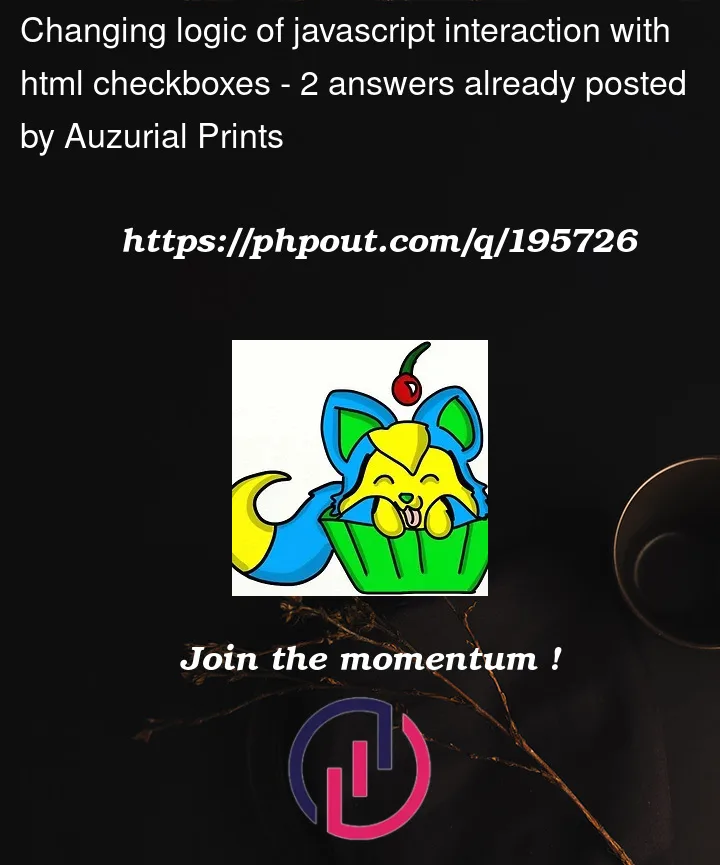Currently the checkboxes do as such.
Ruby Red alters the first svg
Forest Green alters the second svg
Ocean Blue alters the third svg
What I would like to do is make it dependent on what is selected first. So if Ocean Blue is selected first it would change the first svg. If the second was Ruby Red it would change the second svg.
If there is also a way to do this where the svgs have unique class names instead of all being "svg-icon" that would really help me with structure.
I guess one final thing I am looking to achieve is if any of the checkboxes are deselected it "free’s up that spot in essence" So if the first svg was freed up because of deselection the next checkbox selection would take its place.
Any help or pointers in the right direction would be really appreciated. I am trying to make a visualizer to sell my products like soap that I do as a hobby.
const checkboxes = document.querySelectorAll('.checkbox');
const svgs = document.querySelectorAll('.svg-icon');
let selectedIndices = [];
checkboxes.forEach((checkbox, index) => {
checkbox.addEventListener('click', function() {
const className = this.value.replace(/[_d]/g, '');
const targetIndex = selectedIndices.indexOf(index);
if (this.checked) {
if (targetIndex === -1) {
selectedIndices.push(index);
svgs[index].querySelector('path').setAttribute('class', className);
}
} else {
if (targetIndex !== -1) {
selectedIndices.splice(targetIndex, 1);
svgs[index].querySelector('path').removeAttribute('class');
}
}
});
});.svg-icon {
width: 100px;
height: 100px;
}
.rubyRed {
fill: #9b111e;
}
.forestGreen {
fill: #228b22;
}
.oceanBlue {
fill: #00E7FF;
}<input type="checkbox" class="checkbox" value="rubyRed_1">
<label>Ruby Red</label>
<input type="checkbox" class="checkbox" value="forestGreen_2">
<label>Forest Green</label>
<input type="checkbox" class="checkbox" value="oceanBlue_3">
<label>Ocean Blue</label>
<svg class="svg-icon" viewBox="0 0 20 20">
<path fill="#000000" d="M10,0C4.5,0,0,4.5,0,10c0,5.5,4.5,10,10,10s10-4.5,10-10C20,4.5,15.5,0,10,0z M15.3"/>
</svg>
<svg class="svg-icon" viewBox="0 0 20 20">
<path fill="#000000" d="M10,0C4.5,0,0,4.5,0,10c0,5.5,4.5,10,10,10s10-4.5,10-10C20,4.5,15.5,0,10,0z M15.3"/>
</svg>
<svg class="svg-icon" viewBox="0 0 20 20">
<path fill="#000000" d="M10,0C4.5,0,0,4.5,0,10c0,5.5,4.5,10,10,10s10-4.5,10-10C20,4.5,15.5,0,10,0z M15.3"/>
</svg>Im mostly unsure of where to start or what would be the best type of logic to deal with these interactions.




2
Answers
Here is my full solutions, there are some comments which explain what I did.
What I did was create a div wrapper and put all the svg in it then call it with children.
What I used here was a Map to store which SVG was being shown and at which SVG position
For this what I did was to have an array which stored which SVGs were free. Then we can keep track of where to add back the svg on the next click.
I prefilled the positions which were available so we can just grab the first available position (0).
Here is my solution.
Push or Remove the class name from array
result.Reset svgs’ class by result every time checkboxes was clicked.